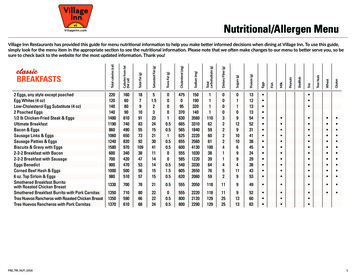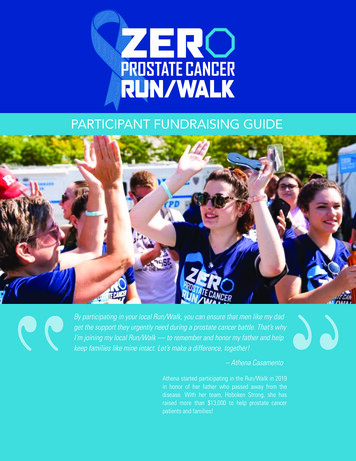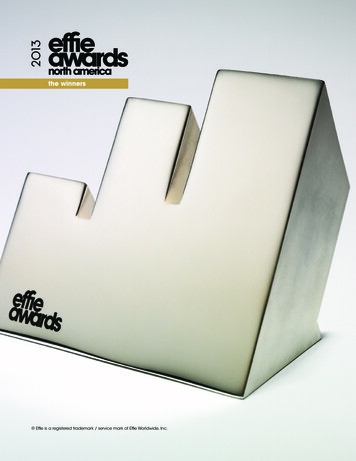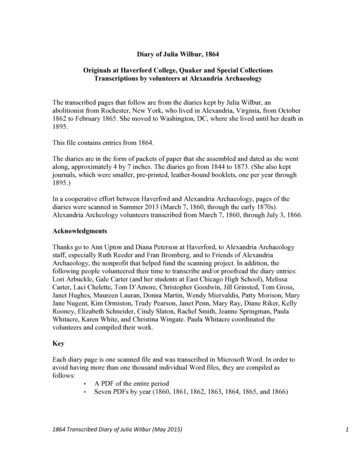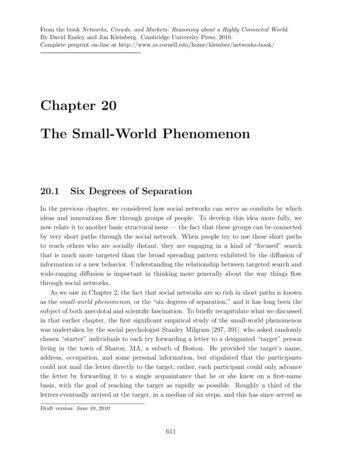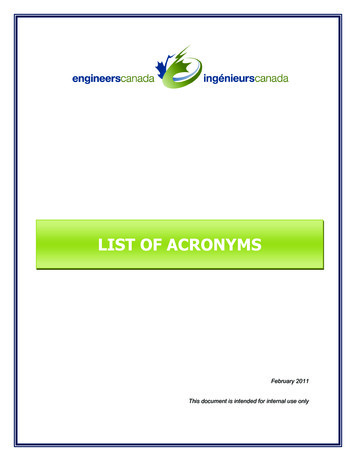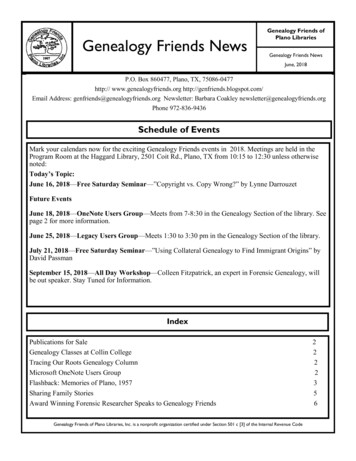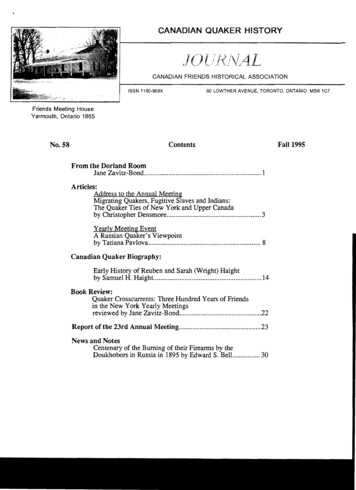
Transcription
CANADIAN QUAKER HISTORYCANADIAN FRIENDS HISTORICAL ASSOCIATIONISSN 1180-968X60 LOWTHER AVENUE, TORONTO, ONTARIO M5R 1C7Friends Meeting HouseYarmouth, Ontario 1865ContentsNo. 58From the Dorland RoomJane Zavitz-Bond. 1Articles:Address to the Annual MeetingMigrating Quakers, Fugitive Slaves and Indians:The Quaker Ties of New York and Upper Canadaby Christopher Densmore. 3Yearly Meeting EventA Russian Quaker's Viewpointby Tatiana Pavlova . 8Canadian Quaker Biography:Early History of Reuben and Sarah (Wright) Haightby Samuel H. Haight. . 14Book Review:Quaker Crosscurrents: Three Hundred Years of Friendsin the New York Yearly Meetingsreviewed by Jane Zavitz-Bond. 22Report of the 23rd Annual Meeting . 23News and NotesCentenary of the Burning of their Firearms by theDoukhobors in Russia in 1895 by Edward S. Bell . 30Fall 1995
The Canadian Quaker History Journal is published twice annually in spring and fallissues by the Canadian Friends Historical Association (as part of the annual membershipsubscription to the Association). Applications for membership may be made to the addresslisted below. Membership fees for 1996 are:Libraries and InstitutionsGeneral MembershipSeniors and StudentsLife Membership 20.00 15.00 10.00 200.00Contents of the published articles are the responsibility of the authors.Copyright 1995 Canadian Friends Historical Association.ISSN 1180-968XG.S.T. No. Rl18831593Editors:Jane Zavitz-BondAlbert SchrauwersProduction:Albert SchrauwersJane Zavitz-BondKathleen HertzbergEditorial Address:Dorland RoomPickering College16945 Bayview AvenueNewmarket, Ont.,L3Y 4X2Letters and submissions from readers are always welcome.Subscriptions and Correspondence:Canadian Friends Historical AssociationFriends House60 Lowther Ave.,Toronto, Ont.,M5R lC7
From the Dorland Room .Stephen Grellet's oft quoted passageexpresses a keen awareness of time. "ifthere is any good that I can do let me do itnow for I shaH not pass this way again."One who appears to have lived by thesewords is Kathleen Hertzberg, who presentedher final message as chairperson at the 1995Annual Meeting. Twenty years have flownby so quickly. She has carried this respon sibility for the association as a specialconcern. We are thankful that she will con tinue her interest in other roles.In this issue of the Journal we havecontributions culled from CFHA sponsoredevents over the last six months. The fIrstarticle was presented by ChristopherDensmore in the afternoon session of theannual meeting. The Canadian connectionswith New York Yearly Meeting are manyand ongoing, even to the original settlers!The pleasure of hearing Chris' paper and thediscussion which followed gave attendersthe opportunity to carry their knowledge ofCanadian Quaker history further. We thankChristopher Densmore for his continuedwork in history, and the ease and clarity hebrings to his papers. He was a major con tributing member of the team which pre pared the history of New York YearlyMeeting out of which the idea for thisprogram emerged. It was also a pleasure tohave Elizabeth H. Moger, Keeper-of-the records of NYYM with us. She added to thediscussion from her great store of knowl edge about New York Friends. She was theoriginator of the idea of a 300th anniversaryhistory of NYYM. Quaker Crosscurrents:Three Hundred Years of Friends in the NewYork Yearly Meetings was published thissummer and is reviewed in this issue.The Annual Meeting was held in theYarmouth Friends Meetinghouse. TheCFHA had last met there in 1976. A historyof Friends in Yarmouth, my fIrst majorcontribution to the Newsletter/Journal, wasunder Jadwega Bennich's editorship.Jonathan Doan came to Yarmouth in 1813and encouraged Friends to settle on the OakPlain while serving as CoL Baby's landagent An allowed meeting for worshipunder Norwich Monthly Meeting was estab lished in 1819, and a preparative meeting in1823, when Sarah Haight arrived as arecorded minister. To have CFHA come tomy home meeting was special to me. Todaythe meeting is active with a number ofgrowing families. The heritage continues. IfJIStheard of Sarah Haight from Paul Zavitzon shipboard as Young Friends sailed tovisit Friends abroad in 1948. Little did Iknow how important she would be to me inthe years to come. The biography of herreprinted in this issue was fJISt published inthe Young Friends Review in Dec.(No. 12)1888 and Jan.(No. 1) 1889, edited by E.M.and S.P. Zavitz, of Coldstream. ArthurDorland referred extensively to it in Historyof Friends in Canada. Our typescript copyis less edited, and we hope readers willenjoy an account of the settlement strugglesfrom the perspective of one who livedthrough them. Sarah and Reuben Haightnever ceased their concern for the meetingand always supported the spiritual life oftheir neighbours. In turn they were support ed in wonderful ways by those neighbours.Once the family was established and thesons older and able to assist the rest of thefamily, life was a bit easier.The Meeting in Yarmouth did notsuffer during the divisive Orthodox-HicksiteSeparation, nor did those established in the1840's in Malahide and Lobo townships.both also preparative meetings to Norwich.This fact that may have bearing on the con tinued existance of Coldstream and Yar mouth meetings today.The article was given to me by EdithE. Zavitz along with her other familypapers. Her mother, Ida Haight, was thedaughter of Ephraim who built a housecopied from the home they left atChappaqua, on the Hudson, in 1817.Brother James built his copy north ofUnion, and Samuel, the author, used thesame model for his home on the Sparta Union Road. It is now our farm home. Wecan imagine what life was like in that place,1
to Poland while Paul Zavitz was workingthere with AFSC/CFSC in reconstruction.He was transporting material to rebuildhomes in the war ravaged fann villages.Now we are into another major shift ofpolitical-economic history. The doors areopening again, as the Sharon Temple'sdoors did for us, joining east a.'1d west, northand south together in common cause. Andat this time we welcome, hear, and respondto Tatiana as she reminds us that time bringschanges in ways we do not expect, withsweeping impact, surprisingly. "If there isany good that I can do let me do it now for Ishall not pass this way again." We are inawe. Under it all are the everlasting annS ofthe spirit of love and peace which we can allembrace and share. We give thanks.Jane Zavitz-Bondit still has an air of peace and welcome. Mydaughter and son-in-law Ken and MarthaLaing now fann the acres organically, andlive in their timber frame house on theridge, back the mile-long lane fromSamuel's house.The second article in this issue is atnmscription of a talk presented by Tatia.'1aPavlova, as the major CFHA event forCanadian Yearly Meeting. The tape record ing from which the transciption was madedid not include the concluding commentsmade by several Friends, including UrsulaFranklin, Margaret Forde and myself. I havebeen asked to share these closing wordsfrom that evening in the Sharon Templehere, since the spirit expressed by thesespeakers so aptly highlighted the impor tance of Tatiana's moving words. Havingspoken without a script in response to theoccasion, this is not an easy task.After hearing Tatiana's speak, Ifound it is so appropriate that we weregathered in the Temple, itself built in thespirit of Quaker values and ideals. Its fourdoors open to the four directions of thecompass so all may enter regardless of theirorigin. We were joined by Friends fromacross Canada who had come to celebratethe fortieth anniversary of the reunificationof Canadian Yearly Meeting. We werejoined by Friends from across NorthAmerica, and now, even Russia. The goldenglobe which hangs between the lanternedpeaks of the Temple represents the universalpeace we seek for the world Darknesscame as we sat. A recorder's musical tonesresonated in the quiet, lifting our hearts andspirits with a hope that peace might indeedcome in the future in the same way that wehad been brought together, that evening. Wemust, can only, do our part and pray otherswill also work to accomplish that dream.Friends have had a number of tieswith the Russian people beginning withPeter the Great and Tsar Alexander's visitsto England; Daniel Wheeler's work in drain ing the estates near St.Petersburg in the 19thcentury; the Doukhobor's coming to Canadanearly a century ago with Tolstoi andQuaker's assistance. In 1920-21 Friendsadministered famine relief in Russia.Nearly fifty years ago eastern Europeshifted to communism after WWII. It cameAcquisitions by the Dorland Room:1) Quaker Crosscurrents: Three HundredYears of Friends in the New York Yearl):Meetings ed. by Hugh Barbour, ChristopherDensmore, Elizabeth H. Moger, Nancy C.Sorel, Alson D. van Wagner and Arthur J.Worrall, with a forward by Martin E. Marty(Syracuse University Press, 1995).2) A copy of William Sewers History of theRise. Increase and PrOgress of the ChristianPeople Called Quakers once owned byYonge Street Quaker Samuel Hughes.Donated by Walter F. Hughes of California.3) A preliminary copy of The HughesFamil):: Quaker Pioneers of Penns):lvaniaby Walter F. Hughes. This 72 page book ofis well illustrated, and traces the migrationof the Hughes family from Wales, to Penn.,Ontario, Wisconsin and California.4) A number of cemetery transciptions pub lished by the Quarterly of the New YorkState Nlagara Genealogical Society werecontributed by Doris Stringers of Fonthill,Ont. They include "Quaker Burial Ground,Haight Rd., Somerset, Niagara Co., NY","Friends Cemetery (Rt. 104) Ridge Rd,Hartland, Niagara Co., NY", "SkinnerFamily Cemetery, Town of Porter, Youngs town, NY", "Kline Cemetery, Lewiston,Niagara Co., NY", "Oark Cemetery, Lewis ton, Niagara Co., NY" and "Town ofRoyalton, Birtha, marriages and Deaths forthe year 1847".2
Address to the Canadian Friends Historical Association Annual Meeting,Sparta, Ontario, October 28, 1995.Migrating Quakers, Fugitive Slaves and Indians:The Quaker Ties of New York and Upper CanadaChristopher Densmoreincluding New York, Ontario and laterMichigan Hicksite Quakers, though withthe decline of the Hicksite meetings inwestern New York and Michigan, it hadbecome a largely Canadian body by thetime of the reunion of the three branches ofFriends in Canada in 1955. The last remain ing New York State meeting in the oldGenesee Yearly Meeting, East Hamburg(NY) Executive Meeting was transferred tothe reunited New York Yearly Meeting in1958, to become Orchard Park MonthlyMeeting. Though New York YearlyMeeting no longer includes any Canadianmeetings, one meeting in New York State,St. Lawrence Valley Friends Meeting, ispart of Ottawa Monthly Meeting ofCanadian Yearly Meeting.From the late 1790s, Quakers inUpper Canada were connected to the widerQuaker world through the organizationalties of the meetings and through the visits ofFriends "traveling in the ministry." NewYork Yearly Meeting was concerned, forexample, that Quakers and their meetingswere well supplied with Quaker books.Canniff Haight's Country Life in CanadaFifty Years Ago, published in 1885, has alist of the library of Haight's Quaker grand father, who died in 1829. While not a largelibrary by modem standards -- only twenty six titles -- it was a well selected collection.People of that era tended to read intensivelyrather than extensively so twenty-sixvolumes, and access to other books at themeeting house, represents a good workinglibrary. About half of the titles were Quakerbooks, including recent works by EliasHicks and Thomas Willis of New York, andJesse Kersey of Pennsylvania. 1However, the library also shows thedual implications of this Quaker connected ness. Hicks, Willis and Kersey were prin For the past five years, I, with anumber of others, including ElizabethMoger, Keeper of the Records of New YorkYearly Meeting, Alson Van Wagner, Chairof the Records Committee of New YorkYearly Meeting, and a number of other his torians and Quaker participant observershave been at work on a history of New YorkYearly Meeting. That history was finallypublished in June 1995 by SyracuseUniversity Press under the title of QuakerCrosscurrents: Three Hundred Years ofFriends in the New York Yearly Meetings.Not coincidentally, 1995-1996 is theTercentenary of New York Yearly Meeting.Quaker Crosscurrents is the New Yorkequivalent of Arthur G. Dorland's History ofthe Society of Friends in Canada (1927),and we hope that our book, like Dorland's,will not be the fmal word, but will insteadserve as outline and a contextual aid forfurther research.Canadian Quakers are a part of ourbook. Quakers have their own sense ofgeography, which often ignores politicalgeography and national boundaries. Theboundaries of New York Yearly Meetingwere largely a product of migration, so thatNew York Yearly Meeting has includedlocal meetings in northern New Jersey, thewestern portions of Massachusetts andConnecticut, the State of Vennont, Quebec,Upper Canada, Michigan, and even a coupleof meetings in northern Pennsylvania andnorth-west Ohio. Orthodox Friends inCanada were part of New York YearlyMeeting until they were "set off' from NewYork Yearly Meeting in 1866. In 1834, theHicksite branch of New York YearlyMeeting set off the quarterly meetings inwestern New York, and those in UpperCanada, to fonn Genesee Yearly Meeting.This body was always trans-national,3
might have otherwise objected to thechanges brought about by the "newmethods" in the 1870s, had already left asWilburites thirty years earlier. The oneexception in New York Yearly Meeting isLeRay Monthly Meeting in northern NewYork which joins Canada Yearly Meeting(Conservative). The Wilburites in NewYork State, and the Conservatives inCanada and LeRay remain separate bodiesuntil the early 1900s when the Wilburitesalso join Canada Yearly Meeting(Conservative). New York Wilburitesremain part of Canada Yearly Meeting untilthe reunion in 1955, when the New YorkWilburite meetings are laid down and thefew remaining members rejoin the reunitedNew York Yearly Meeting.So far, I have talked about organiza tional matters which are far easier to docu ment than social networks and patterns ofinfluence.In 1842, Joseph C. Hathaway, aQuaker living in Farmington, New York,wrote to the National Anti-Slavery Standardabout some of his recent house guests. Onesuch guest, a nineteen year man old fromVirginia was on his way to Canada. Hismaster, for the man was a slave, hadwagered him against HXX) in a cock-fight"He thought it best to use the physical andintellectual powers that God had given him,in finding a country where an immortalbeing is considered of too much value tohave his destiny hang upon a chicken'sfoot." The same letter told of another fugi tive slave, living openly in Geneva, NewYork, and working as a barber, when his oldmaster walked in for a shave. "He shavedhim with a trembling hand; and the momenthe left the shop, hurried out of the backdoor, and immediately fled to Canada."Later that summer, Hathaway wrote aboutanother visitor, who seeing reward postersoffering 600 for his capture, had not daredto seek assistance until near the end of hisjourney. Without any assistance, he hadtraveled, presumably on foot, at least theentire breadth of Pennsylvania and half ofNew York State, before boarding theUnderground Railroad. 2Canada contributed two notableagents in the Michigan branch of theciple figures in the Hicksite-Orthodox con troversies of the 1820s. The visits of travel ing Friends to Canada, and the travels ofCanadian Friends, like Nicholas Brown, tothe States, virtually insured that the contro versies which had begun on Long Islandand in Philadelphia would also trouble theCanadian meetings. Philadelphia YearlyMeeting divided into Orthodox and Hicksitebranches in 1827, and New York YearlyMeeting divided in turn in 1828. By 1829,the division was universal throughout theYearly Meeting, and Canadian as well asNew York Friends would remain divided,at least organizationally, until 1955.ThoughcontroversiesamongFriends continued throughout the nineteenthcentury, no other controversy had theimpact of the Hicksite-Orthodox Separation.In contrast to the wide-ranging impact ofthat event, the separation led by DavidWillson and others in the Yonge StreetMonthly Meeting in 1812 which resulted increation of the Children of Peace at Sharonhad no discernible impact on Quakerismbeyond the local area, even in Canada,despite the publication by Willson ofpamphlets in New York and Philadelphia,and the appeals of several disowned Friendsto New York Yearly Meeting. Conversely,the withdrawal of Wilburite Friends inFerrisburg, Scipio and Fannington quartersof New York Yearly Meeting in the late184Os, seems to have no impact onCanadian Friends. Neither did the with drawal of the Congregational or ProgressiveFriends in New York and Michigan fromGenesee Yearly Meeting in 1848 affect theunity of Canadian Hicksites. As a result ofthe Progressive separation in Michigan,Michigan Quarterly Meeting was laid downand the remaining Hicksite meetings inMichigan attached to Pelham QuarterlyMeeting.The apparent lack of Wilburite senti ment in Canada in the 1840s and 1850s isnoteworthy because in the 1870s and 1880s,Canada Yearly Meeting (Orthodox) splitinto Conservative and, for lack of a betterterm, Gurneyite factions. This time, NewYork Yearly Meeting (Orthodox) does notsplit, possibly because the more conserva tive members of the Yearly Meeting who4
Nation. It is quite possible that the schoolwas the one sponsored by Genesee and NewYork Yearly Meeting (Hick site) and taughtby Friend Griffith M. Cooper. The juxtapo sition of Quakers, Indians, fugitive slavesand Indians in Mabbett's letter seems inci dental, but also occurs in a letter written byPhiladelphia Friend Lucretia Mon to theLiberator in 1848. This letter includes inalmost equal portions descriptions of hervisits with "self-emancipated slaves" inBuffalo, Detroit, Chatham, Dawn, London,and Toronto, and of her visit, as part of theIndian Committee of Philadelphia YearlyMeeting, to the Seneca Indians at theCattaraugus Reservation. The landmarkSeneca Falls Woman's Rights Convention to"consider the relative position of women insociety" merits two lines in a lengthyletter. SQuakers from New York andPhiladelphia Yearly Meetings worked withthe Senecas in New York State from the1790s onward. An intriguing result of thisQuaker effort came in June 1812. MajorJohn Norton, at a council held at GrandRiver, was attempting to enlist Iroquoissupport for the coming war between theUnited States and Great Britain. During thiscouncil, two of the "most respectable" ofthe Seneca chiefs approached Norton statedtheir intentions to stay out of the comingconflict.Underground Railroad, Laura SmithHaviland and Elizabeth L. Comstock. LauraHaviland's father came to Upper Canadafrom eastern New York and her motherfrom Vermont. Haviland was born in KitleyTownship, County of Leeds, Upper Canadain 1808. In 1815, the family moved furtherwest, to Niagara County in New York State,then in 1829, most of the Quakers ofRoyalton Meeting in Niagara Countymoved yet further west to MichiganTerritory. Quite likely they traveled north ofLake Erie on their way to Michigan, passingthough the Quaker communities at Pelham,Norwich or Sparta. During this long west ward migration, Laura remained within theboundaries of New York Yearly Meeting. In1858, she was joined in the work of aboli tion by another immigrant from Canada,the English born Elizabeth L. Comstock.Comstock was a Friends minister and in the1870s was one of those who brought the"new methods" of Midwestern Friends toNew York Yearly Meeting. Comstock'sfmal years were spent in Union Springs,New York, where she advocated thereconciliation of Orthodox, Hicksite andWilburite Friends. 3Lorenzo Mabbett, from CollinsCenter, in southern Erie County, New York,was another Quaker conductor on the URR.In 1849, he wrote to the North Star, aboutsome of his own guests who had to cut shorttheir stay in New York State.Seeing therefore, that no good canbe derived from War, we think weshould only seek the surest means ofaverting its attendant Evils: -- Weare of the opinion that we shouldfollow the example of some of theirpeople [the Quakers], who neverbear arms in war, & deprecate theprinciples of hostility. 6A few hours since Anna G. Mabbettwas seen upon one of our back roadswith a horse and wagon containingbesides herself a fugitive slave andhis wife, all in women's attire. Theslave was about to commence schoolon the Reservation with the Indians,when his friends learned that thebase ministers of Slaveocracy wereon his track and close upon him . 4I cannot, on this slender evidence,claim that the Iroquois desire for neutralitywas motivated by the example of Quakerpacifism. In September 1812, a Councilof Oneida, Onondaga, Stockbridge andTuscarora addressed the President of theUnited States on the subject of the war.They reminded the President that it was theUnited States government under Washing These accounts are intriguing, butalso point out how little we know about themechanism of the Underground Railroad.Canada is so unspecific as a destination.The Mabbett account also mentionsthe fugitive intending to attend school onthe Cattaraugus Reservation of the Seneca5
ton that had advised them to refrain fromshedding blood:stood the Iroquois to be a religious andmoral people, and that Seneca outwardreligious practices were no more or lessabsurd than the ceremonies practiced bythe various Christian denominations.Whatever Quakers thought of HandsomeLake's teachings as a whole, they endorsedthe fruits of his teachings which called onthe IrCXluois to be sober, industrious andpeaceful. So while I do not consider theLonghouse Religion to be a form ofQuakerism, I think a case can be made thatthe Quakers, by teaching and example,helped to legitimize it as a cultural choice.Thus the existence of the LonghouseReligion in Canada today does owe some thing to the work of Quakers at Alleghanytwo centuries ago.I must note that New York Iroquoiswere not successful in their initial intentionto remain neutral in the War of 1812.However,their involvement largelylimited to the Battle of Chippewa in July1814. Following the battle, the Seneca chiefRed Jacket sent a proposal to fellowIroquois who had sided with the British fora mutual withdrawal from the fighting andmost, though not all, of the Iroquois took nofurther part in the war. This very limitedparticipation on the part of the Senecastands in stark contrast to the seven years ofharsh warfare that marked Iroquois involve ment in the War for American Indepen dence.The earliest substantial accounts wehave of Quakers in Upper Canada are by products of the Quaker-Iroquois connection.In 1793, Philadelphia Yearly Meeting wasinvited by both the Seneca and the UnitedStates government to act as observers at atreaty to be held at Sandusky in the Ohiocountry. During their travels to and fromDetroit, which included discussions withGovernor Simcoe at Navy Hall in modernNiagara-on-the-Lake, Joseph Moore andJacob Lindley visited Quakers living on theNiagara Peninsula. 9How did these early Quakermigrants to Upper Canada fit into Canadiansociety? What was their contribution?While I assume that the motivating factorbehind most migration, including that ofQuakers into Canada is economic, why didthis advice was good. Our goodprophet of the Seneca tribe. hasgiven us the same advice, and ourtribes have entered into a league tofollow that advice. We wish to holdfast to it, and not to take any part inthe contest between your people andthe British}The "good prophet" is HandsomeLake, and the "Code of Handsome Lake" isthe basis of the Longhouse Religion that isthe form of traditional Iroquois religionpracticed today among the Iroquois in NewYork and Ontario. The vision of HandsomeLake has been described as a combinationof Quakerism and traditional Iroquois reli gion. 8 It is true that Quakers fromPhiladelphia Yearly Meeting were teachersand frequent visitors to the AlleghanyReservation at the time of HandsomeLake's vision, and there are areas of simi larity in the message of Handsome Lake andthe Quakers. Was there a Quaker influenceon the Longhouse Religion? Possibly, but Itend to be skeptical of that claim.What is clear to me is that Quakersfunctioned as cultural mediators among theIroquois. They were Euro-Americans, butclearly distinct from other Euro-Americansand perceived by the Iroquois as being wellintentioned toward the Indians and thususeful as a source of information about Euro American behavior.The Quakers thought that theirprimary function among the Seneca was toteach agriculture, that is Euro-Americanagriculture as the Iroquois were already anagricultural people, and the mechanicalarts. However, I think that they also taughtby example that it was possible to dissentfrom the broader culture. Quakers providedan ethical basis for minority group survival.The choice before the Iroquois was there fore not simply adopting or rejecting in totalthe white man's ways, but they could, likethe Quakers, be selective in their choices.Quaker atti tude toward Indianreligion amounts to a particularly Quakerform of fundamentalism. Quakers under 6
Timothy Rogers chose to move north ofLake Ontario at a time when many VermontQuakers were moving into the newlyopened lands of the Holland Purchase inwestern New York? Why did LauraHaviland's parents move back to New YorkState in 1815?It does seem likely that the earliestQuaker migrants who settled in the NiagaraPeninsula in the late 1780s consciouslychose to live under British government.Quakers, though they attempted to remainapart from the warring factions in theAmerican War for Independence, wereoften considered by the patriot forces to beloyalists and tories and were sometimesroughly treated. For some Quakers, Britishtoleration, despite its limits, seemed pre ferable to an uncertain future in the newUnited States.The Quakers as allies of the Britishis the theme of a very curious of documenta tion that I encountered while working onthis paper. The document is a print, firstpublished during the War of 1812, and thenreissued in New York during the CanadaRebellion. The title is "British Warfare in1812, 1837-38." On the left side of theprint is the depiction of a British soldieroffering rum to an Indian in return forscalps; on the right side, a British officerencourages a slave to set fire to a building.The print is made relevant to the UpperCanada Rebellion by the depiction in thebackground of the burning of the"Caroline. " In the center of the print is thefigure of a Quaker inciting a slave to arsonby means of a document labeled "Libertyfor Negroes." 10 What this has to do with theUpper Canada Rebellion, other than achance for a New York printmaker to makemoney by recycling a twenty year old imageand "twisting the British lion's tail" isbeyond me. Why the Quaker? Am I missingsome logical connection that would havebeen obvious to someone in 1838?Perhaps it is best to end on this noteof perplexity. The aim of the editors andauthors of Ouaker Crosscurrents was toprovide a framework. We have told part ofthe story, but there is more that could bedone. We know a little bit about Quakers inNew York and Upper Canada, and a littlebit about Quakers and abolition, and a littlebit about Quakers and Indians, but wedo not fully understand all of the connec tions or the implications of those connec tions. There is much work to be done.Notes:1. Canniff Haight, Country Life in Canada FiftyYears Ago (Toronto: Hunter, Rose and Co., 1885),182; the listing for the Elias Hicks' Sermons couldrefer to one of several collections published between1825 and 1829; Jesse Kersey was the author of ATreatise on the Doctrines of the Christian Religion(1815), and Thomas Willis was the author of Replyto Hibbard (1812).2. National Anti-Slavery Standard. May 5, 1842,August 11, 1842.3. Laura Smith Haviland, A Woman's Life-Work 4thedt (Chicago: Publishing Association of Friends,1889) and Caroline Hare, edt Life and Letters ofElizabeth L. Comstock (London: Headley Brothers,1895). For Comstock's comments in 1886 on thedifferences between the branches of Friends and herhopes for reconciliation, see pp. 468-70.4. North Star, Sept 29, 1849.5. Liberator, October 6, 1848; see also her husbandJames Mott's account of their Canadian visits in theP lvania Free July 27,1848.6. The Journal of Major John Norton. Edited by CarlF. Klinck and James J. Talman. (Toronto: ChamplainSociety, 1970),290-91.7. William Ketcham, An Authentic andComprehensive History of Buffalo. Vol. 2 (Buffalo:Rockwell, Baker and Hill, 1865),424-5.8. Elizabeth Taylor-Rossinger, "The Quakers and theIroquois." Canadian Qpaker HistoI)' Journal 57(Summer 1995),19-20.9. See "Jacob Lindley's Account of a Jour-ney toAttend the Indian Treaty" Friends Miscellany 2(1832): 49-156, especially 71, 75, 151-2, and"Joseph Moore's Journal of a Tour to Detroit,"Friends Miscellany 3 (1833): 289-343, especially294-96, 332-35. For a later visit by Lindley to visitFriends on the Niagara Peninsula in 1797, seeFriends Miscelg 3 (1833): 351-65.10. The image is reproduced in Jane Errington, TheLion. the Eagle, and UJWer Canada: A Develo,piniColonial Ideoloa;y (Kingston: McGill QueensUniversity Press, 1987), 76, and in Peter C.Marshall, Deadly Medicine: Indians and Alcohol inEarly America (Ithaca: Cornell University Press,1996),173.7
Canadian Friends Historical Society Yearly Meeting Eventheld 23 Aug., 1995 at the Sharon Temple Historic Site and MuseumTatiana Pavlova - A Russian
papers. Her mother, Ida Haight, was the daughter of Ephraim who built a house copied from the home they left at Chappaqua, on the Hudson, in 1817. Brother James built his copy north of Union, and Samuel, the author, used the same model for his home on the Sparta Union Road. It is now our farm home. We
